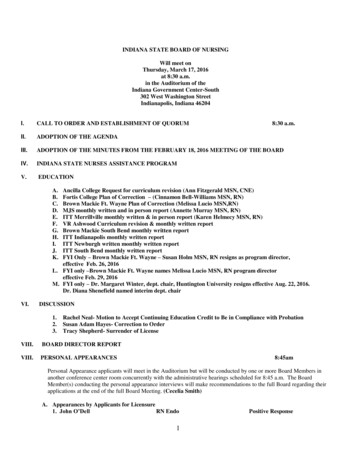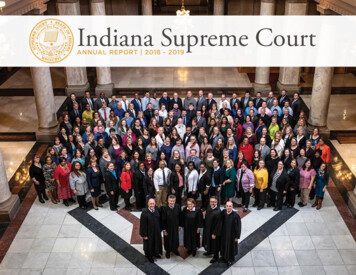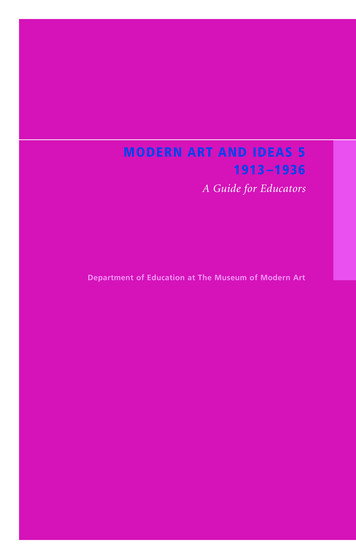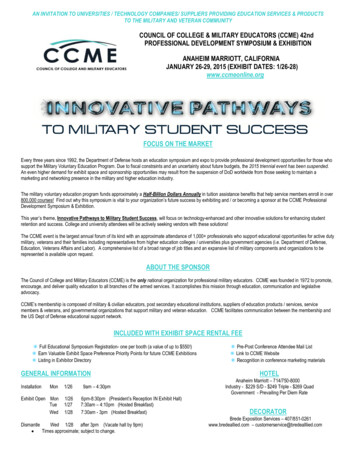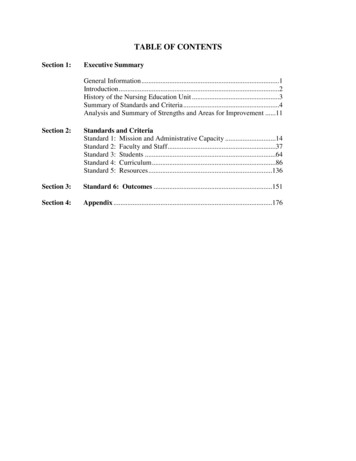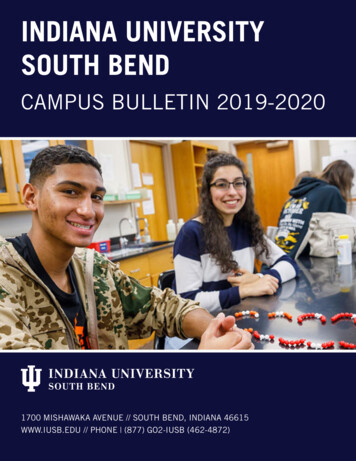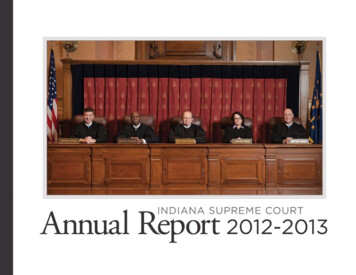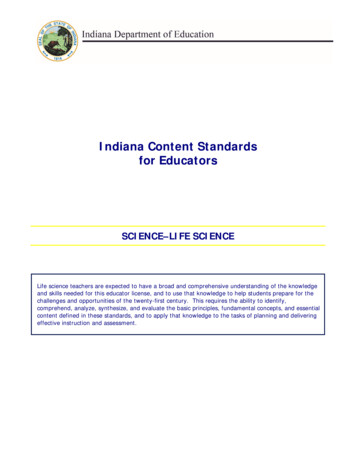
Transcription
Indiana Content Standardsfor EducatorsSCIENCE–LIFE SCIENCELife science teachers are expected to have a broad and comprehensive understanding of the knowledgeand skills needed for this educator license, and to use that knowledge to help students prepare for thechallenges and opportunities of the twenty-first century. This requires the ability to identify,comprehend, analyze, synthesize, and evaluate the basic principles, fundamental concepts, and essentialcontent defined in these standards, and to apply that knowledge to the tasks of planning and deliveringeffective instruction and assessment.
Table of ContentsScience–Life Science Educator Standards . 1Selected Bibliography of Standards and Sources Related toScience–Life Science. 6Alignment of Teacher Standards with State and National Standards . 8
Science–Life ScienceEducator StandardsStandard 1: The Nature and Processes of ScienceLife science teachers have a broad and comprehensive understanding of the nature of science and the processesof scientific inquiry.Standard 2: Central Concepts and Connections in ScienceLife science teachers have a comprehensive understanding of the core ideas in other science disciplines and ofthe relationships between science, engineering, technology, and society.Standard 3: Cellular Chemistry and StructureLife science teachers have a broad and comprehensive understanding of cellular chemistry, structures, andfunctions.Standard 4: OrganismsLife science teachers have a broad and comprehensive understanding of the organization and structures oforganisms and the processes involved in growth, maintenance, and reproduction.Standard 5: InterdependenceLife science teachers have a broad and comprehensive understanding of ecological principles, the interactionsbetween living and nonliving components of ecosystems, and the relationships between organisms.Standard 6: Heredity and GeneticsLife science teachers have a broad and comprehensive understanding of the molecular basis of heredity, theprocesses of cell division, and the principles of genetics.Standard 7: EvolutionLife science teachers have a broad and comprehensive understanding of evolution, the history of life on earth,and modern taxonomic classification.Standard 8: Science Instruction and AssessmentLife science teachers have a broad and comprehensive understanding of content-specific instruction andassessment in science.The Indiana Educator Standards for Science–Life Science describe the knowledge and skills that teachersneed to help students achieve the learning outcomes defined by the Indiana Revised Academic Standardsfor Science Grade 5–Grade 8, Biology I, and Anatomy and Physiology. Links to relevant portions of theIndiana Academic Standards can be found below.Grade 5Grade 6Grade 7Grade 81Biology IAnatomy and Physiology
Science–Life ScienceEducator StandardsStandard 1: The Nature and Processes of ScienceLife science teachers have a broad and comprehensive understanding of the nature of science andthe processes of scientific inquiry, including:1.1the characteristics, assumptions, and goals of science1.2the tentative nature of scientific knowledge, which is subject to change as new evidence, new tools, ornew ways of thinking become available1.3the formulation of testable hypotheses and the principles and procedures for designing and conductingscientific investigations1.4common tools, materials, and technology used in life science investigations1.5the collection, organization, analysis, interpretation, and communication of scientific data, including theuse of technology1.6the safe execution of laboratory exercises and safe storage and disposal of chemicals and other materials1.7the role and applications of mathematics in science1.8the characteristics and uses of various sources of scientific information and the evaluation of scientificinformation, claims, and arguments1.9the role of peer review and critical evaluation of the results of scientific investigations, models, andexplanationsStandard 2: Central Concepts and Connections in ScienceLife science teachers have a comprehensive understanding of the core ideas in other sciencedisciplines and of the relationships between science, engineering, technology, and society,including:2.1the unifying concepts and processes that cut across the sciences and engineering2.2the basic concepts and major principles of physical science2.3the basic concepts and major principles of Earth and space science2.4the basic characteristics, principles, and goals of the engineering, or technological, design process2.5the interconnections between the various disciplines of science2.6the interrelationships between science and technology2.7the social, cultural, and ethical aspects of science and technology2.8the historical development of important ideas in science from different periods and cultures2
Science–Life ScienceEducator StandardsStandard 3: Cellular Chemistry and StructureLife science teachers have a broad and comprehensive understanding of cellular chemistry,structures, and functions, including:3.1the properties of biologically important elements, ions, and compounds, such as carbon and water, andtheir roles in living systems3.2the structures, properties, and functions of carbohydrates, lipids, proteins, and nucleic acids and theprocesses involved in their synthesis and breakdown3.3the properties of enzymes and enzyme-mediated reactions3.4the structures and functions of membranes, organelles, and other cellular and extracellular components3.5the inputs and products, biochemical pathways, and cellular structures and components involved inphotosynthesis and cellular respiration3.6the characteristics and functions of cells from various types of organisms and specialized cells withinmulticellular organisms3.7basic physiological functions and homeostatic mechanisms of cellsStandard 4: OrganismsLife science teachers have a broad and comprehensive understanding of the organization andstructures of organisms and the processes involved in growth, maintenance, and reproduction,including:4.1the hierarchical levels of organization in multicellular organisms4.2the characteristics of stem cells and the process of cellular differentiation4.3the structure, organization, function, and roles of different types of tissues in organisms4.4the functions and interrelationships of organs in organ systems4.5the structures, physiological processes, and behaviors of various organisms for carrying out essential lifefunctions, including obtaining and using matter and energy4.6the structures, processes, and strategies used by organisms to maintain homeostasis4.7reproductive strategies, developmental characteristics, and life cycles of organisms from differenttaxonomic groups4.8basic anatomy and physiology of the primary components of human body systems3
Science–Life ScienceEducator StandardsStandard 5: InterdependenceLife science teachers have a broad and comprehensive understanding of ecological principles, theinteractions between living and nonliving components of ecosystems, and the relationshipsbetween organisms, including:5.1abiotic and biotic factors and their effects on organisms in an ecosystem5.2characteristics of populations and factors that affect population growth and size5.3the types of relationships and interactions between organisms in an ecosystem5.4the flow of energy and the cycling of matter through ecosystems5.5the characteristics of food webs; the roles of producers, consumers, and decomposers; and theinterdependence of organisms within a food web5.6factors that affect the stability of an ecosystem5.7changes in ecosystems over time5.8the impact of human activities and natural phenomena on ecosystems and the effects of such changes onbiodiversityStandard 6: Heredity and GeneticsLife science teachers have a broad and comprehensive understanding of the molecular basis ofheredity, the processes of cell division, and the principles of genetics, including:6.1the structure of DNA and RNA and the processes of replication, transcription, translation, and proteinsynthesis6.2the characteristics and functions of genes, mechanisms of gene regulation, and the control of geneexpression6.3the relationships among DNA, chromosomes, and genes6.4types of mutations and chromosomal abnormalities and their common causes and effects6.5the processes and outcomes of mitosis, meiosis, and binary fission6.6the behavior of chromosomes during cell division and the relationship to hereditary patterns6.7sources of genetic variation in populations6.8the principles of genetics, patterns of inheritance, and their application to genetics problems6.9the basic principles, methods, and applications of genetic engineering4
Science–Life ScienceEducator StandardsStandard 7: EvolutionLife science teachers have a broad and comprehensive understanding of evolution, the history oflife on earth, and modern taxonomic classification, including:7.1modern evolutionary theory and its historical development and supporting evidence7.2the process of natural selection, conditions necessary for natural selection to occur, and factors thataffect natural selection and the development of adaptations in a population7.3the use of evolutionary theory in explaining the unity and diversity of life7.4scientific theories of the origins and history of life on earth and supporting evidence7.5the use of biochemical, fossil, anatomical, developmental, and genetic evidence to establish evolutionaryrelationships between organisms7.6similarities and differences in organisms from various taxonomic groups7.7modern methods and systems of taxonomic classificationStandard 8: Science Instruction and AssessmentLife science teachers have a broad and comprehensive understanding of content-specific instructionand assessment in science, including:8.1the Indiana Revised Academic Standards for Science8.2the National Science Education Standards, the NCATE/NSTA Standards for Science Teacher Preparation,the Common Core State Standards for Literacy: Science & Technical Subjects, and ISTE NationalEducational Technology Standards8.3instructional strategies and resources for promoting students' development of conceptual understanding,inquiry skills, and scientific habits of mind8.4strategies and skills for planning and designing science instruction, including the use of techniques andapproaches that meet the needs of diverse learners8.5instructional strategies and communication methods that encourage active inquiry, supportive interaction,and collaboration in the science classroom8.6strategies and resources for promoting students' reading, writing, and mathematics skills in science8.7strategies and skills for selecting, adapting, and using technological resources to enhance teaching andlearning in science8.8procedures, resources, and guidelines for maintaining a safe science learning environment and ensuringthe humane and ethical treatment of living organisms8.9strategies and skills for effectively assessing student understanding and mastery of essential scienceconcepts and skills5
Selected Bibliography of Standards andSources Related to Science–Life ScienceState and National Standards and Curriculum Frameworks1.Indiana Department of Education. (2010). Indiana revised academic standards for rds 03 29 10.pdf2.Council of Chief State School Officers (CCSSO)/National Governors Association (NGA). (2010). Commoncore state standards for English language arts & literacy in history/social studies, science, and technicalsubjects. http://www.corestandards.org/assets/CCSSI ELA%20Standards.pdf3.National Research Council. (1996). National science education standards. Washington, DC: The NationalAcademies Press. http://www.nap.edu/catalog/49624.National Science Teachers Association. (2003). Standards for science teacher NSTA/NSTAstandards.doc5.International Society for Technology in Education (ISTE). (2008). National educational technologystandards for teachers. http://www.iste.org/Libraries/PDFs/NETS for Teachers 2008 EN.sflb.ashx6.American Association for the Advancement of Science. (1993). Project 2061: Benchmarks for scienceliteracy. New York: Oxford University Press. t.htm7.National Research Council. (2010). A framework for science education: Preliminary public draft.Sources on Science–Life Science Content8.American Association for the Advancement of Science and the National Science Teachers Association.Atlas of science literacy, Volume 1 (2001) and Volume 2 (2007). Washington, DC: American Associationfor the Advancement of Science.9.Koba, S., & Tweed, A. (2009). Hard-to-teach biology concepts: A framework to deepen studentunderstanding. Arlington, VA: NSTA Press.10.Duncan, R. G., Rogat, A. D., & Yarden, A. (2009). A learning progression for deepening students'understandings of modern genetics across the 5th–10th grades. Journal of Research in Science Teaching,46 (6), 655–674.11.Catley, K., Lehrer, R., & Reiser, B. (2005). Tracing a prospective learning progression for developingunderstanding of evolution. Paper commissioned by the National Academies Committee on Test Designfor K–12 Science Achievement, National Academy of Sciences.12.Baram-Tsabari, A., & Yarden, A. (2007). Interest in biology: A development shift characterized using selfgenerated questions. American Biology Teacher, 69 (9), 532–540.6
Selected Bibliography of Standards andSources Related to Science–Life ScienceSources on Student Learning and Pedagogical Methodology13.Committee on Science Learning, Kindergarten Through Eighth Grade, National Research Council. (2007).Taking science to school: Learning and teaching science in grades K–8. (R. A. Duschl, H. A.Schweingruber, & A. W. Shouse, Eds.). Washington, DC: The National Academies Press.14.Committee on High School Science Laboratories: Role and Vision, National Research Council. (2005).America's lab report: Investigations in high school science. (S. R. Singer, M. L. Hilton, & H. A.Schweingruber, Eds.). Washington, DC: The National Academies Press.15.Bransford, J. D., & Donovan, M. S. (2005). Scientific inquiry and how people learn. In M. S. Donovan &J. D. Bransford (Eds.), How students learn: History, mathematics, and science in the classroom.Washington, DC: The National Academies Press.16.Weiss, I. R., Knapp, M. S., Hollweg, K. S., & Burrill, G. (Eds.). (2001). Investigating the influence ofstandards: A framework for research in mathematics, science, and technology education. Washington,DC: The National Academies Press.17.Committee on the Development of an Addendum to the National Science Education Standards onScientific Inquiry, National Research Council. (2000). Inquiry and the national science educationstandards: A guide for teaching and learning. Washington, DC: The National Academies Press.7
Alignment of Educator Standardswith State and National StandardsIndiana Educator Standardsfor Science–Life ScienceIndiana RevisedAcademicStandards forScienceStandard 1: The Nature andProcesses of ScienceGr. 5–8 ProcessStandards,Life science teachers have abroad and comprehensiveunderstanding of the nature ofscience and the processes ofscientific inquiry.Biology &Anatomy andPhysiology Natureof ndiana CoreStandards forScienceGr.Gr.Gr.Gr.5–8, CS – A;5–8, CS – G;9–12, CS – A;9–12, CS – GNCATE/NSTAStandards forScienceTeacherPreparationStandard 1 –B.4.33–34,C.2.b.20,C.2.c.25;Standard 2 –Nature of Sci.;Standard 3 –Inquiry;Standard 9 –Safety & WelfareStandard 2: Central Conceptsand Connections in ScienceGr. 5–8 ProcessStandards;Life science teachers have acomprehensive understanding ofthe core ideas in other sciencedisciplines and of the relationshipsbetween science, engineering,technology, and society.Biology &Anatomy andPhysiology Natureof ScienceStandards;5.1, 6.1, 7.1, 8.1,5.2, 6.2, 7.2, 8.2,5.4, 6.4, 7.4, 8.4Gr.Gr.Gr.Gr.5–8, CS – E;5–8, CS – F;9–12, CS – E;9–12, CS – FStandard 1 –B.4.29, Standard 4 –Issues5.1, 6.1, 7.1, 8.1,5.2, 6.2, 7.2, 8.2,5.4, 6.4, 7.4, 8.48Common CoreState Standardsfor Literacy:Science &TechnicalSubjectsReadingGr. 6–8, 1–10;Gr. 9–10, 1–10;Gr. 11–12, 1–10ISTENationalEducationalTechnologyStandards
Alignment of Educator Standardswith State and National StandardsIndiana Educator Standardsfor Science–Life ScienceStandard 3: CellularChemistry and StructureIndiana RevisedAcademicStandards forScienceNationalScienceEducationStandardsIndiana CoreStandards forScience6.3, 7.3, B.1–3,AP.16.3, 7.3, B.1–3,AP.1Gr. 5–8, CS – C;Gr. 9–12, CS – CStandard 1 –B.1.5, C.2.a.8,C.2.a.10,C.2.b.13–146.3, 7.3, B.3,AP.2–157.3, B.3,AP.2–15Gr. 5–8, CS – C;Gr. 9–12, CS – CStandard 1 –B.1.1, B.1.6–8,C.2.a.1, C.2.a.8,C.2.a.105.3, 6.3, B.3, B.45.3, 6.3, B.3, B.4Gr. 5–8, CS – C;Gr. 9–12, CS – CStandard 1 –B.1.3, B.1.6,C.2.a.5–6,C.2.a.9,C.2.a.12,C.2.b.14Life science teachers have abroad and comprehensiveunderstanding of cellularchemistry, structures, andfunctions.Standard 4: OrganismsLife science teachers have abroad and comprehensiveunderstanding of the organizationand structures of organisms andthe processes involved in growth,maintenance, and reproduction.Standard 5: InterdependenceNCATE/NSTAStandards forScienceTeacherPreparationLife science teachers have abroad and comprehensiveunderstanding of ecologicalprinciples, the interactionsbetween living and nonlivingcomponents of ecosystems, andthe relationships betweenorganisms.9Common CoreState Standardsfor Literacy:Science yStandards
Alignment of Educator Standardswith State and National StandardsIndiana Educator Standardsfor Science–Life ScienceStandard 6: Heredity andGeneticsIndiana RevisedAcademicStandards forScienceNationalScienceEducationStandardsIndiana CoreStandards forScienceNCATE/NSTAStandards forScienceTeacherPreparation7.3, 8.3, B.5–7,AP.1, AP.158.3, B.5–7, AP.1,AP.15Gr. 5–8, CS – C;Gr. 9–12, CS – CStandard 1 –B.1.7, C.2.a.7,C.2.b.15,C.2.b.218.3, B.88.3, B.8Gr. 5–8, CS – C;Gr. 9–12, CS – CStandard 1 –B.1.4,C.2.a.2–4,C.2.b.16,C.2.b.19Standard 8: ScienceInstruction and AssessmentTeachingStandards A–E,Standard 5 –Teaching,Life science teachers have abroad and comprehensiveunderstanding of content-specificinstruction and assessment inscience.AssessmentStandards A–EStandard 6 –Curriculum,Life science teachers have abroad and comprehensiveunderstanding of the molecularbasis of heredity, the processes ofcell division, and the principles ofgenetics.Standard 7: EvolutionLife science teachers have abroad and comprehensiveunderstanding of evolution, thehistory of life on earth, andmodern taxonomic classification.Standard 8 –Assessment,Standard 9 –Safety & Welfare10Common CoreState Standardsfor Literacy:Science &TechnicalSubjectsReadingGr. 6–8, 1–10;Gr. 9–10, 1–10;Gr. 11–12, 1–10WritingGr. 6–8, 1–10;Gr. 9–10, 1–10;Gr. 11–12, –1d, 2a–2d,3a–3d, 4a–4b
7. National Research Council. (2010). A framework for science education: Preliminary public draft. Sources on Science–Life Science Content 8. American Association for the Advancement of Science and the National Science Teachers Association. Atlas of science literacy, Volume 1 (2001)



